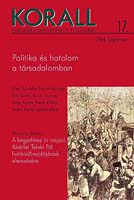Hatalom – lakásrendszer – társadalom. Egy lipótvárosi bérház lakói 1941 és 1960 között
Power – Housing – Society. Tenants of a Lipótváros Apartment House between 1941 and 1960
Author(s): Ágnes NagySubject(s): History
Published by: KORALL Társadalomtörténeti Egyesület
Keywords: social history; Hungary; 20th century; housing; Budapest; flat; long-term social changes; social stratification; Jewry
Summary/Abstract: In 1944–1945, in 1951 and in 1956 the population of Budapest underwent waves of migration due to the violent intervention of political powers. The round-up of the capital’s Jewry in July 1944, the siege of the city, the 1951 deportations and the wave of emigration in 1956 were all movements of the population that led to the vacancy of masses of tenement flats and brought about the spatial and social restructuring of the population of Budapest’s rental zone. Replacing the rental flat market of the period between the two world wars, the framework for the forced movements between tenements flats during these three periods – that are easily discernible in the written sources due to their clear temporal limits - was the system of the distribution of flats overseen by the authorities and later centralized by the state. The system of the requisition and distribution of flats qualified as Jewish following March 19th 1944 was carried on in 1945 – for flats over a given size – to manage the mass homelessness caused by anti-Jewish measures and the siege, and became permanent as the party-state centralized it. Highlighting the waves of the movements of the population between the turn of the 1930’s-1940’s and 1960 due to the forced intervention of political powers, and viewing these in the context of the housing system allows us to examine the long-term changes in the composition of the population of the rental districts of Budapest. Examination of the long-term changes of the composition of society is possible in several temporal segments on the basis of quantifiable census data, electoral registers and the housing registers containing the occupation of the dwellers. Comparison of these segments makes it possible to identify the extent to which such occupational-social groups were affected by the movements, the changes in their proportion within the entire population, their disappearance or, on the contrary, their continuity. Reconstructing the changes in the tenants of a single building between 1941 and 1960 within Pest’s inner rental area, Nádor utca 5. in the Lipótváros district, tracing the movements of individuals and families between the flats on the micro-level brings to light the mechanisms underlying such movements. Behind the statistically measurable changes in the proportions of the various social-occupational groups, we are able to grasp the spatial structure of the movements between the flats and the personal – family, career, domestic – relationships organizing occupations and co-tenancies that underlie the practices of adaptation or resistance within the boundaries set by the political powers.
Journal: Korall - Társadalomtörténeti folyóirat
- Issue Year: 2004
- Issue No: 17
- Page Range: 138-166
- Page Count: 29

